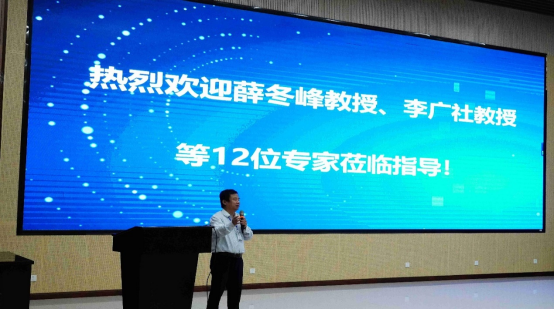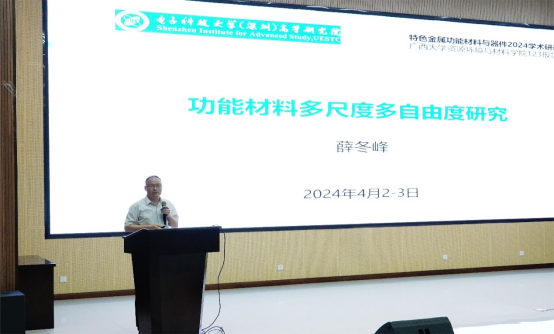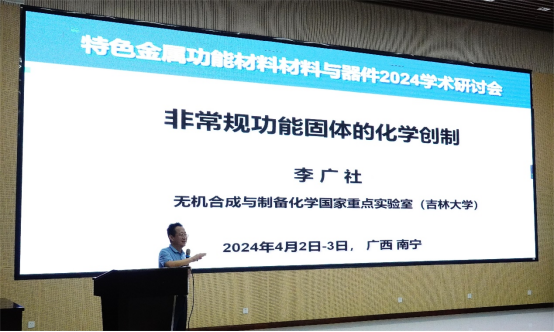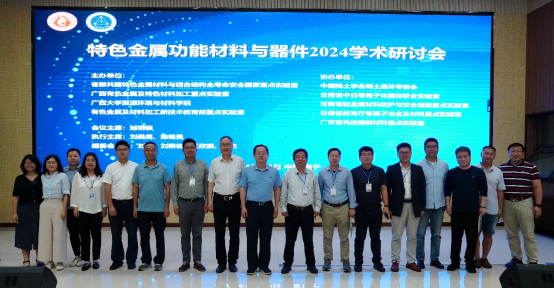The 2024 Academic Symposium on Specialized Metal Functional Materials and Devices was successfully held.
From April 2 to 3, 2024, the 2024 Academic Symposium on Specialized Metal Functional Materials and Devices was successfully held at the Resource, Environment, and Materials College of Guangxi University. The event was organized by the National Key Laboratory for Specialized Metal Materials and Composite Structures Life Safety, the Ministry of Education Key Laboratory for New Technologies in Nonferrous Metal and Material Processing, the Guangxi Key Laboratory for Nonferrous Metal and Specialized Material Processing, and the Resource, Environment, and Materials College of Guangxi University. It was co-organized by the Rare Earth Crystal Committee of the China Rare Earth Society, the International Joint Laboratory of Plasma in Yunnan Province, the Key Laboratory for Light Metal Materials Protection and Safe Energy Storage in Henan Province, the Plasma Metallurgy and Material Key Laboratory of Yunnan Province, and the Advanced Energy Storage Materials Key Laboratory of Guangdong Province.
The symposium featured presentations from 13 renowned scholars, including Professor Xue Dongfeng from the Advanced Institute of Electronics Technology, Shenzhen, and Professor Li Guangshe from Jilin University. The event began with a welcoming address from Professor Bingsuo Zou, Executive Deputy Director of the National Key Laboratory and Dean of the Resource, Environment, and Materials College at Guangxi University. Attendees included Shen Daqiang, Secretary of the College Party Committee, Wu Dahui, Deputy Secretary of the Party Committee, Vice Deans Sun Xiang, Luo Nengneng, Wang Xinpeng, and Chen Xiyong, Director of the National Key Laboratory Office, along with over 200 faculty members and students.
Over the two days, the symposium focused on material innovations supporting the national "dual carbon" strategy and enhancing new productive forces to serve the national new materials industry. Experts and scholars engaged in lively discussions and exchanges on Guangxi's specialized metals and related functional materials and devices in fields such as renewable energy, intelligent displays, and green catalysis. The successful hosting of this symposium will further strengthen collaborations with universities such as Dalian University of Technology and South China University of Technology in material and environmental sciences. It will also enhance synergistic innovations with the Chinese Academy of Sciences and other leading domestic universities, leveraging Guangxi's unique metal resources and regional advantages. This is of significant importance for advancing the regional "Renewable Energy Development Plan and Efficient Utilization of Resources" in Guangxi.

Dean Bingsuo Zou's Welcome Address
Dean Bingsuo Zou, on behalf of Guangxi University and the National Key Laboratory for Specialized Metal Materials and Composite Structures Life Safety, warmly welcomed all the distinguished experts and scholars attending the conference. He provided an introduction to the university's unique advantages and the development history of the key laboratory.
Dean Zou emphasized that the convening of this academic symposium would further promote both fundamental and applied research on Guangxi's specialized metal resources in the fields of new energy materials and devices, intelligent displays, green catalysis, and solid waste treatment. He highlighted the importance of reinforcing the support for the national new materials and devices industry, enhancing the development of new productive forces, and advancing the construction of Direction One of the National Key Laboratory for Specialized Metal Materials and Composite Structures Life Safety at Guangxi University.

Professor Dongfeng Xue's Keynote Presentation
Professor Dongfeng Xue, a recipient of the National Science Fund for Distinguished Young Scholars, a recipient of the State Council Special Allowance, and the Director of the Rare Earth Crystal Committee of the Chinese Rare Earth Society, from the Shenzhen Institute of Advanced Technology, University of Electronic Science and Technology of China, delivered a keynote presentation titled "Multiscale and Multidegree Research on Functional Materials." He conducted an in-depth analysis and discussion with the attending faculty and students on the crystallization processes at multiple scales within material systems and their functional behaviors. His presentation sparked significant interest among the participants in the research directions of new functional crystal materials.

Professor Guangshe Li's Presentation and Collaborative Discussions
Professor Guangshe Li, a recipient of the National Science Fund for Distinguished Young Scholars and the State Council Special Allowance, as well as the Director of the State Key Laboratory of Inorganic Synthesis and Preparative Chemistry and the Director of the Institute of Composite Materials at Jilin University, presented on "Chemical Creation of Unconventional Functional Solids." He shared significant achievements and progress in the synthesis, structure, and performance research, as well as the applications of unconventional functional oxides. His presentation was followed by in-depth discussions with the faculty and students present.
Additionally, Professor Feng Liang from Kunming University of Science and Technology, Professor Jun Liu from South China University of Technology, Researcher Xinheng Li from the Lanzhou Institute of Chemical Physics of the Chinese Academy of Sciences (CAS), Researcher Qichong Zhang, Researcher Hongzhen Lin, and Researcher Shan Cong from the Suzhou Institute of Nano-Tech and Nano-Bionics of CAS, Professor Kunfeng Chen from Shandong University, Associate Professor Keyan Li from Dalian University of Technology, Assistant Researcher Ke Xu from the Shenzhen Institutes of Advanced Technology of CAS, along with Professors Meinan Liu and Tao Liu from Guangxi University, also delivered insightful academic reports on the theme of "Functional Materials and Devices of Special Metals." Their presentations were warmly received by the attendees, and extensive academic exchanges took place.
The conference concluded on a high note with participants reluctantly bidding farewell, having agreed to strengthen future collaborations and reunite in subsequent academic gatherings.

Group photo of experts at the meeting